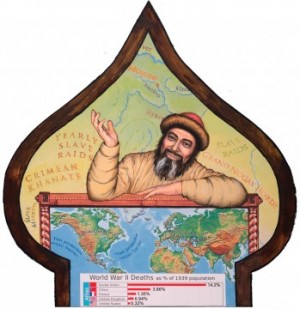-
EXH: PEASANTS, CLANS, AND EFFERVESCENT ABSOLUTISTS!

Tuesday, September 4, 2018 to Thursday, October 18, 2018 Harriman Institute Atrium, 12th Floor International Affairs Building (420 W 118th St) Exhibit runs September 4 – October 18, 2018. Exhibit hours are Monday–Friday, 9:00AM – 5:00PM excluding university holidays.
Artist Anne Bobroff-Hajal has a PhD in Russian History and is the author of the scholarly volume Working Women in Russia Under the Hunger Tsars. Her extensively researched polyptychs are satirical commentaries on how Russia’s ruling elites have historically taken advantage of their unique geographic situation to amass and maintain power. She means for her art to honor and serve the dispossessed and forgotten.
Bobroff-Hajal’s work draws formally on the similarities among icons, political cartoons, animation storyboards, and graphic novels, all of which tell stories in pictures. Her tales are told across centuries to the Infant Stalin by three tsarist godparents: Ivan IV, Catherine the Great, and Peter the Great. Each polyptych is “narrated” via the artist’s original lyrics set to the tune of Kalinka, in a series of tableaux which viewers “read” through numbered frames or simply from left to right. Bobroff-Hajal’s goal is to beguile viewers to identify and engage with forces that have shaped power structures in Russia and other parts of the world.
Intellectually, Bobroff-Hajal’s work brings together disparate fields’ analyses of Russia: historians of ideology who have observed Russian elites’ centuries-old use of the threat of invasion to unify the country behind an autocratic leader; global history scholars like Perry Anderson who wrote that “Eastern Absolutism…was the price of [Russians’] survival in a civilization of unremitting territorial warfare;” geographers who have described Russia as “the least defensible country on earth” because of its vast flatland steppes devoid of natural barriers to invasion. Putin today is only the most recent Russian ruler to manipulate threat of invasion across the plains to support extreme appropriation of wealth and power from the populace for the benefit of ruling elites.
Bobroff-Hajal’s 110-page fully illustrated catalogue is now published online, with extensive historical analysis and info about her artistic process. Please click here to access the catalogue. For best results view using the “full screen” function.
Historian J. Arch Getty wrote,
Anne Bobroff-Hajal’s art combines deep historical knowledge with humor and artistic talent that speaks to audiences ranging from school children to professors. I cannot imagine a more distinctive and iconoclastic combination. In her formidable painting of Ivan IV, his stern face conveys a series of meanings, and the postures of his underlings depict patronage and clan relationships that reflect the latest historical research on the 16th century. Her paintings of Stalin with Bolshevik patronage clans show a similar skill and informed artistry that also capture recent research. Her Catherine the Great, who ‘flies’ by means of stilt-walking serfs hoisting her and her heavy decorative gold wings, does more, and more vividly than many books on Catherine. The whimsical style of her work allows it (like icons of old) to tell stories on many levels, ranging from the nearly comic to an accomplished complexity. Her work is truly unique and deserves a wide audience.
From the artist:
“I’ve been asked how I can bear to spend so much time painting brutality and horrors. I do it because art—with its color, beauty, satire, story, whimsy—is the tool we humans have to lift us from despair as we investigate the sources of atrocities so as to combat them in the future.
How do elites—not only in Russia, but the world over—amass the power to do such terrible things to less powerful people? What are the resources rulers use to accumulate power? How do they exploit those resources to maintain their omnipotence? How have some some regions of the world been able to wield dominion over other regions?
Russian absolutism, as historian Perry Anderson observed, not only began earlier than in Europe, it “outlived all its contemporaries, to become the only Absolutist State in the continent to survive intact into the 20th century.” The 1917 collapse of the Tsarist autocracy was followed a decade after the Bolshevik Revolution by the rising Joseph Stalin’s “Communist” autocracy. That in turn collapsed in the 1990s, to be followed a decade later by the rise of a new autocrat-in-the-making, Vladimir Putin. Why do distinctive historic cycles recur in each region of the globe, and how can they be broken?
I believe that each land’s distinct geography presents singular opportunities for elites to build and sustain power. In particular, Russia is by far the planet’s largest flat landscape. Geographers have called Russia the least defensible terrain on earth because of its lack of natural barriers against hugely powerful neighbors. My art explores the web of interconnections between Russia’s unique geography—both natural and human—and its rulers, clans, and laboring classes. I paint the social system Russia’s geography gives rise to, the elites it empowers, and hundreds of tiny portraits of individual people straining to achieve their goals within that system.
It may seem obsessional to paint so many three-inch-high portraits in such a time-intensive way, often using a magnifying glass to paint each face and detail. But I create art to honor and hopefully serve the dispossessed and forgotten. My goal is for my art to delight viewers to identify forces that have shaped varying power structures in different parts of the world, in order to illuminate how they might create change within their own.”
News tagged: